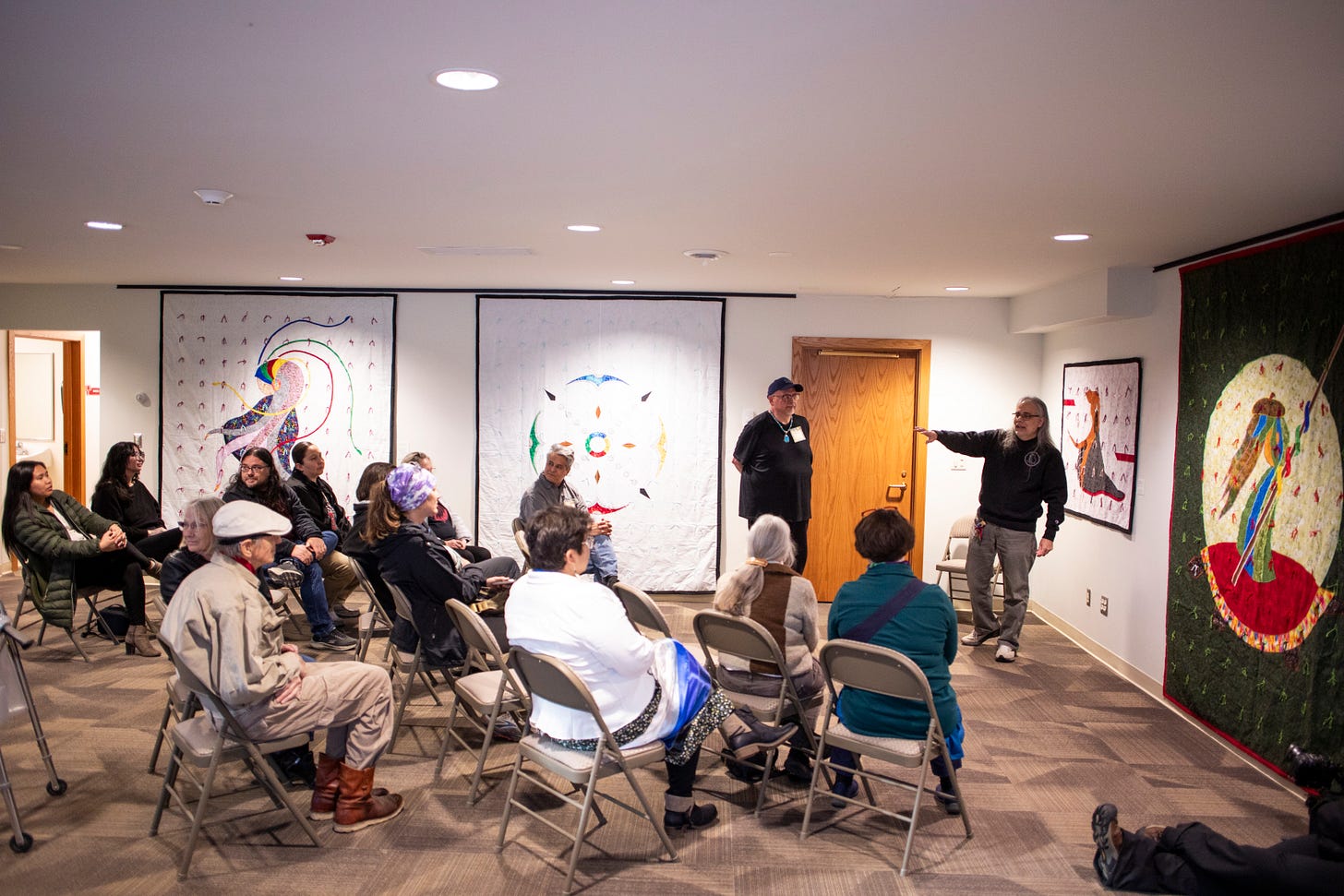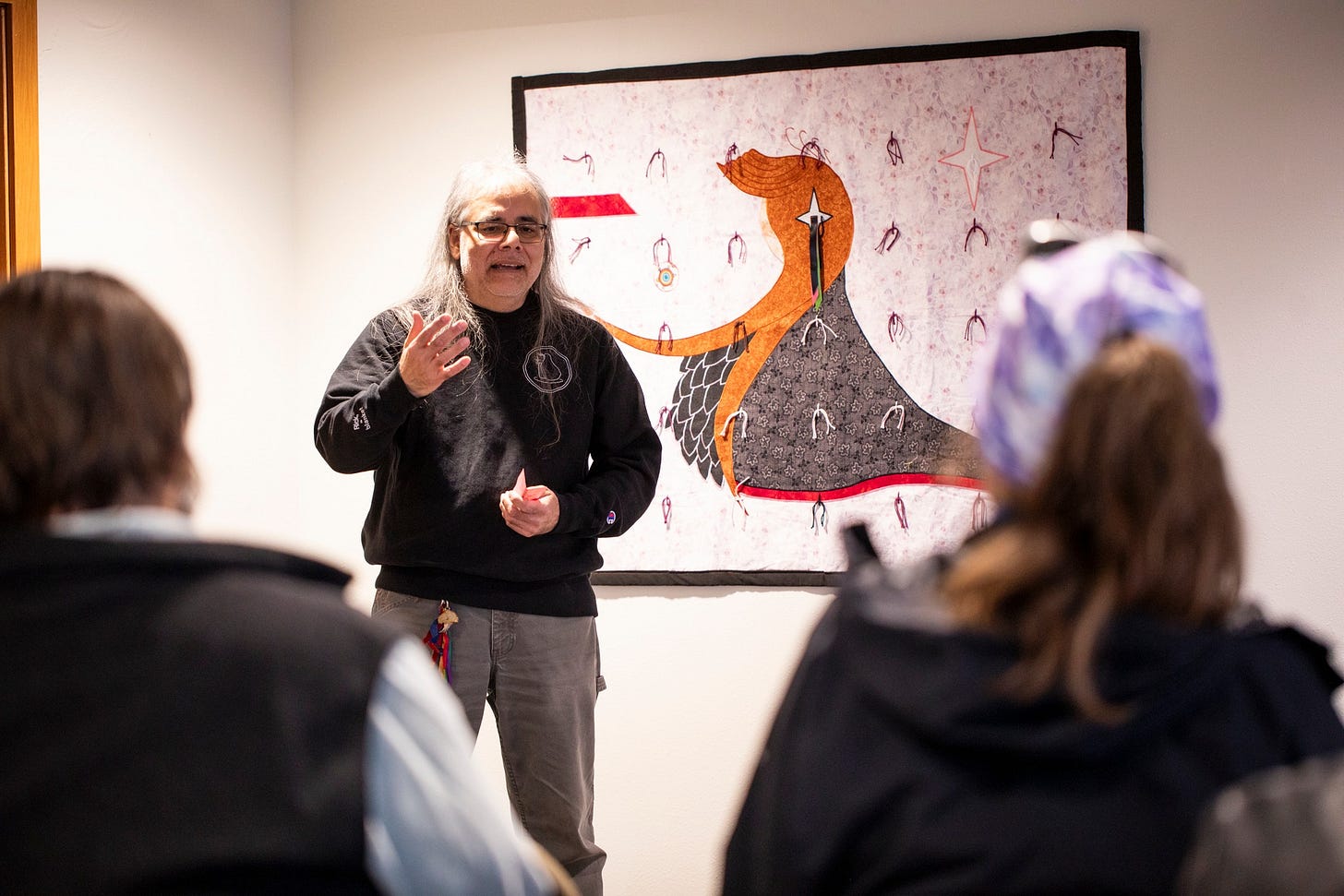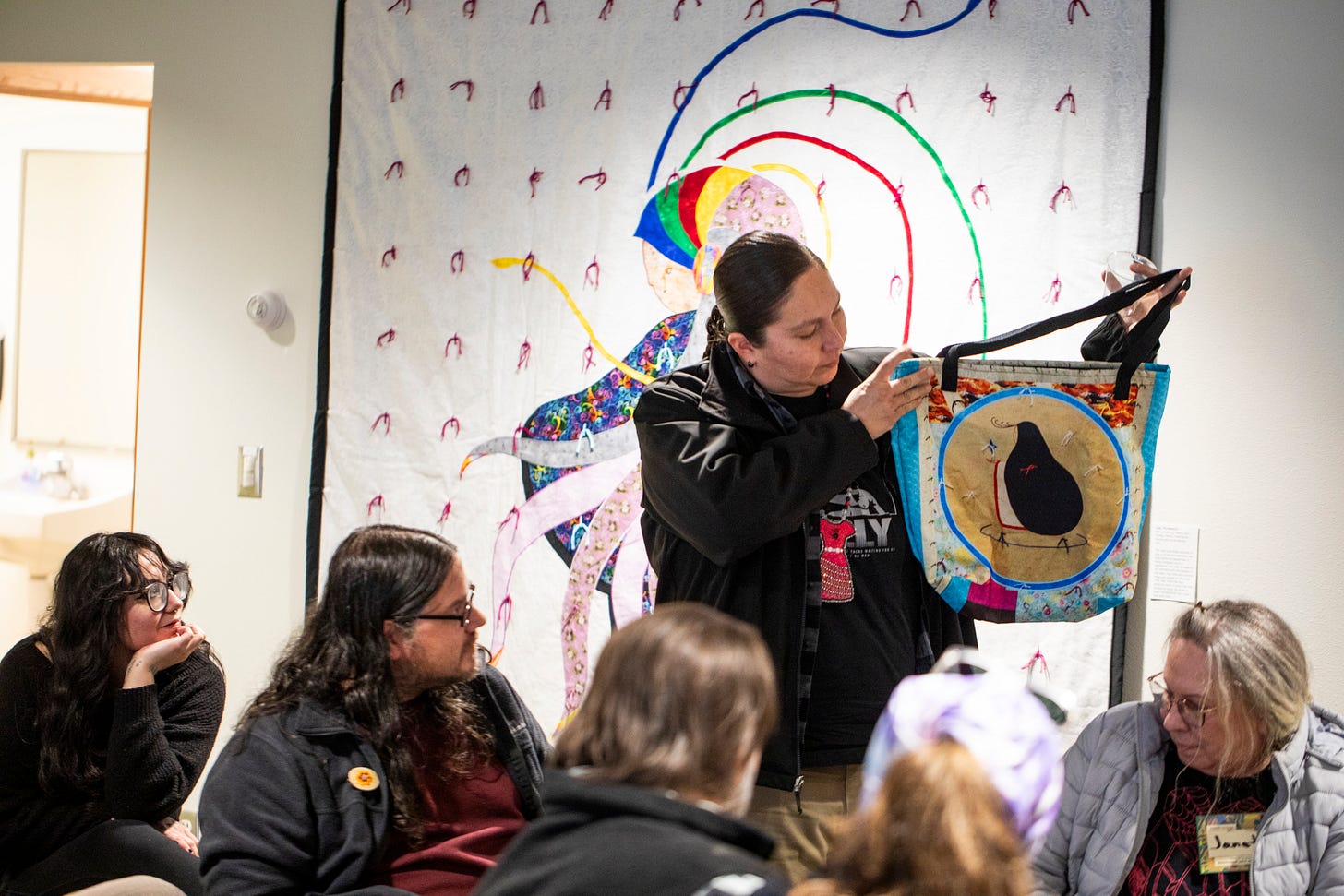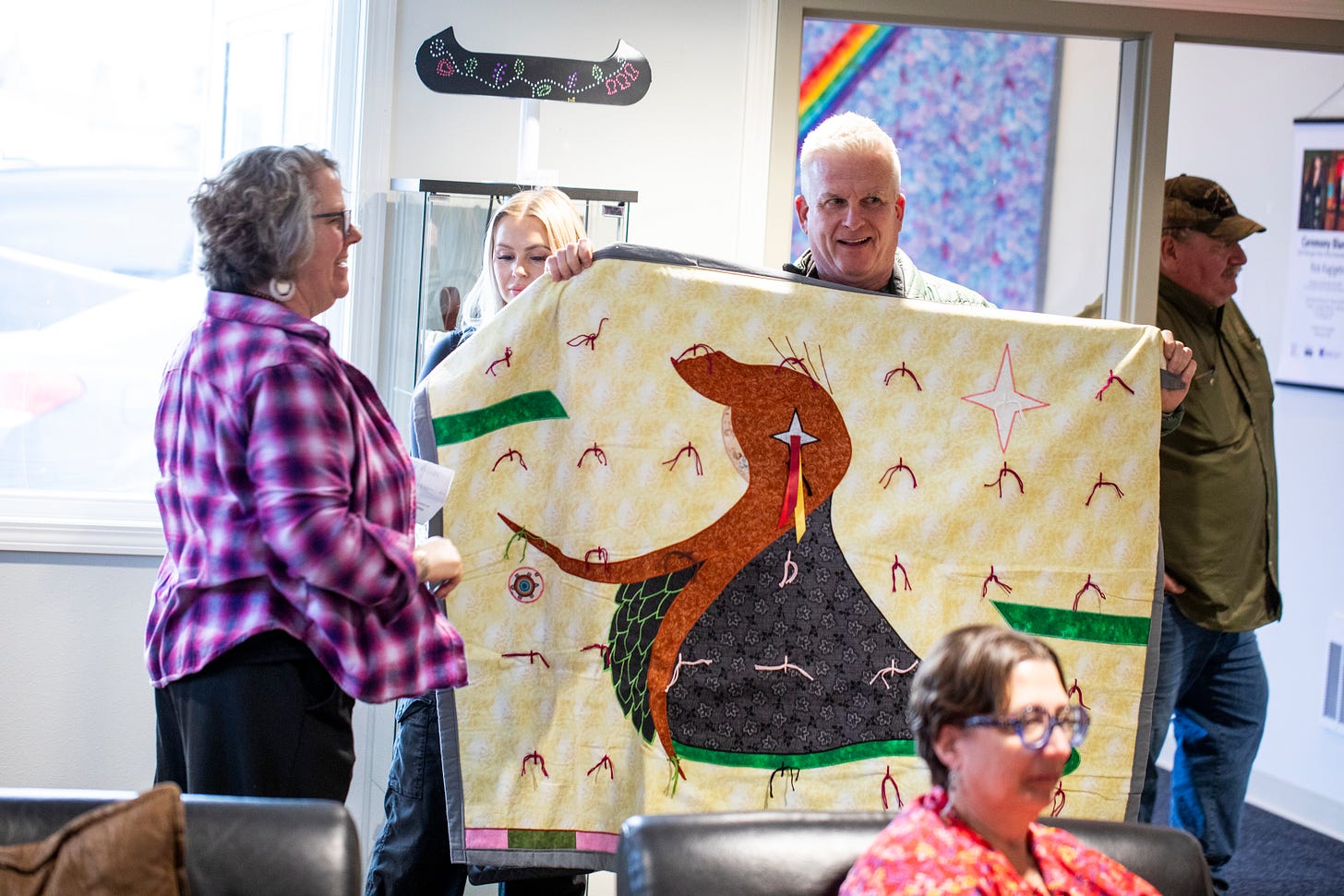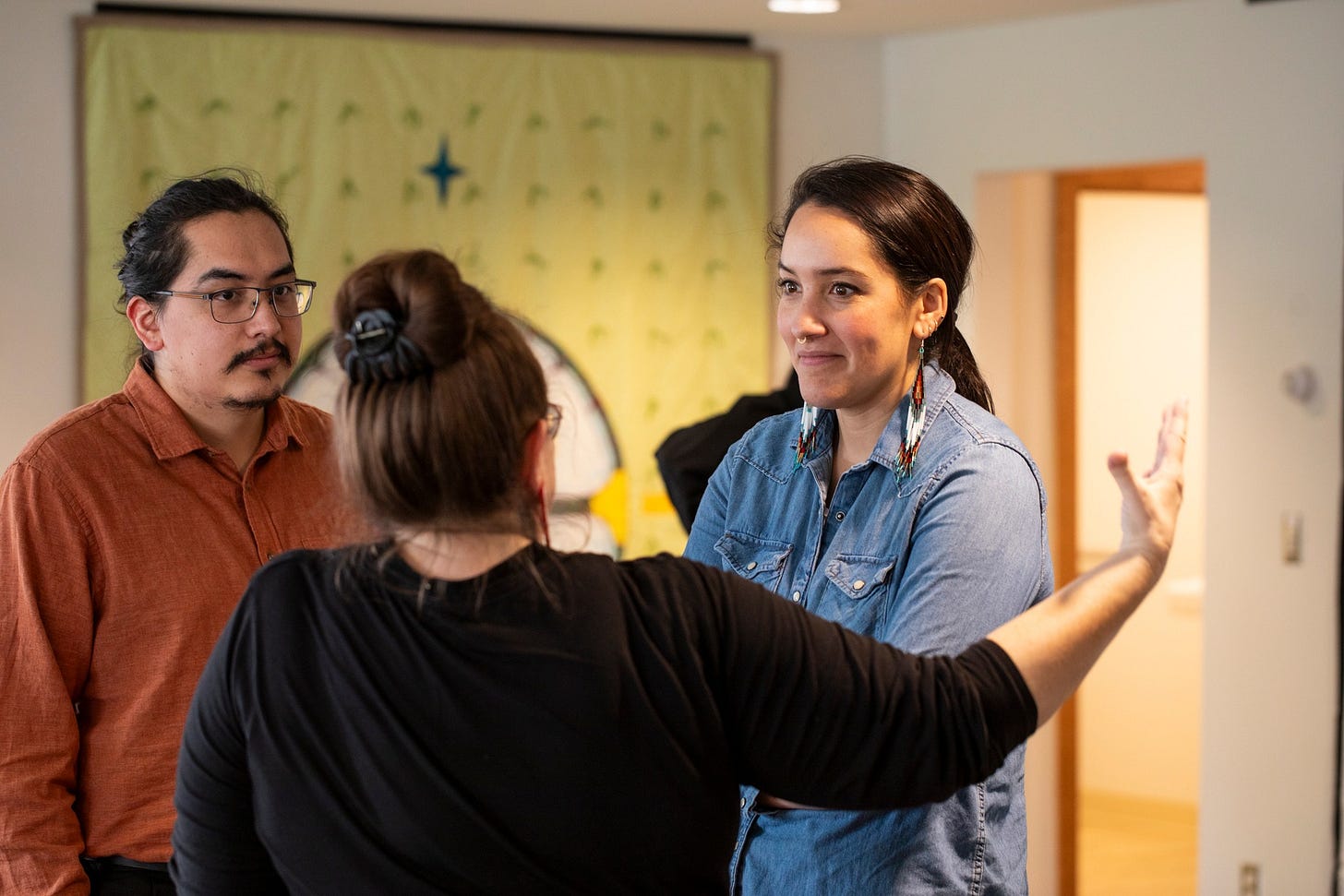The healing, narrative blankets of Rick Kagigebi, 2024 McKnight Fiber Artist Fellow
“Ceremony Blankets” Exhibition at Gizhiigin Arts Incubator Extended Through August 25, 2025
Textile Center is excited to announce Rick Kagigebi’s Ceremony Blankets exhibit is extended until August 25, at Gizhiigin Arts Incubator, 701 E. Jefferson Ave., Mahnomen, MN.
Plan to visit this special exhibition if you’re heading north this summer. Go, just go, and see the phenomenal blankets in Rick’s first exhibition on the White Earth Reservation.
Facilitating 2024 McKnight Fellow Rick Kagigebi’s solo exhibition at Gizhiigin Arts Incubator has been a highlight of my past decade at Textile Center. In my role as director for the McKnight Fellowships for Fiber Artists, getting to know Rick and his work has been an absolute joy and privilege. Throughout his fellowship year, I looked forward to showing his blankets at Textile Center – to honor his work, share it widely, and be a tiny part of his legacy as a maker.
One of my responsibilities within the fellowship program is to help fiber artists navigate decisions that impact both creative practice and community. McKnight Foundation holds the belief that when “artists and culture bearers thrive, Minnesota thrives.” Personally, as someone who embraces a be here now ideology, I find great meaning in supporting a foundation that activates creative communities to “deepen the dimension and quality of our lives.” It makes our Minnesota home a better place.
Rick’s request to hold his fellowship exhibition at Gizhiigin Arts Incubator on the White Earth Reservation provided an opportunity to travel a McKnight Fellowship exhibition out into Greater Minnesota – and is the first McKnight fellowship exhibition to take place on Native land in the state.
Rick is a blanket maker – a next level blanket maker – whose work was described as having serious “mojo” by one of the McKnight jurors. He is also a mentor, leader, medicine person, healer, and storyteller through his work. Narrative drives every blanket design, and many of the stories he tells invite you to imagine the blanket as a 3D sphere, its components laden with symbolism and meaning. The top, middle, and bottom layers contain fabrics and motifs loaded with metaphor — some general, some heavy — all open to interpretation.
Rick creates his blankets both knowingly and unknowingly, some commissioned for ceremony, others guided by vision. He knows every blanket will find its rightful and proper owner out in the world, waiting to be wrapped, nurtured, and healed by his careful and inspired work.
During the exhibit reception on March 18, 2025, Rick’s artist presentation was animated, serious, dry, passionate, and humorous — all at once. When he speaks, a story pours forth, fresh thoughts mingled with phrases I’ve heard consistently over the past 18 months of working with him. Here are a few excerpts from conversations and the presentation:
“For many years, people have told me that the blankets I’ve made helped them. Many commissioned blankets are personal blankets. People will wrap themselves up in the blanket when they need help. I’ve been told that being able to make these blankets is a unique gift that comes with the responsibility to help in this way.
Blankets are a core element in Indigenous cultural life – used both as a robe through the day and to sleep at night. Blankets are shelter, warmth, an expression of generosity, a place of safety. Babies are swaddled and protected in their first blanket. Spouses are wrapped together in their wedding ceremony. Blankets are given within the ceremonial community as a sign of respect to the spirit helpers who are called on; and to show one’s personal investment, how much they want healing and a good life.
Within ceremony, blankets are sent out to carry healing to distant communities. Blankets are imbued with medicine and prayers for long, good lives. When we die, we are again wrapped in a blanket as we begin our journey home.”
At 64, Rick is becoming an Elder in his community, and asks the audience to consider using the term elder — not elderly. Elder is a noun, imbued with respect, deserving of age and experience. As an elder, Rick reminds the audience that when he was younger, opportunities for the support of artists was nothing like it is now. Funding for the arts has exploded over the past few decades under the direction of philanthropies like McKnight Foundation’s Arts and Culture Fellowships, their funding of the state’s Regional Arts Councils (RAC’s), and the Legacy Amendment that funds our State Arts Board. These programs are stepping stones for creative folks wanting to build committed careers in the arts. Opportunities are there for those who are ready to do the work.
During the installation day and the artist reception, I met so many talented Native artists, saw images of their work, and heard stories about their practices, how they learned, and where they were going. Bits of personal histories are always grounding for me, and added to my welcome and connections at Gizhiigin. Thanks to everyone that supported Rick’s work and made this extended exhibition possible: Penny Kagigebi, curator, community activist, and artist; Joseph Allen, artist and Gizhiigin Arts Incubator Coordinator; Kent Estey, artist and Mahnomen Arts Initiative Director; Tara Mason, artist; Patrick Calder-Calder-Carriere, director and the staff of Region 2 Arts Council; and Candace Stock, Indigenous Foods Chef, who kept us fed and nurtured.
— Tracy Krumm, Textile Center Director for Artistic Advancement
(Photos by TJ Turner)




